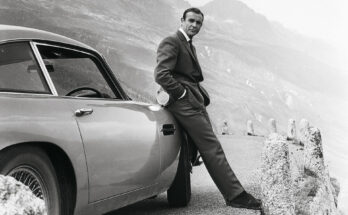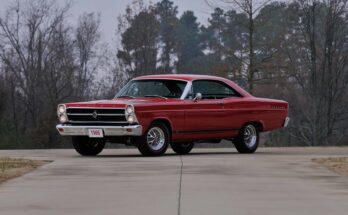The 1965 Ford Mustang, an iconic pony car, never came factory-equipped with both supercharging and twin-turbocharging. These are aftermarket modifications, as the original 1965 Mustang offered a range of naturally aspirated or single-carbureted engines, with the top-tier being the 289-cubic-inch V8 producing up to 271 horsepower in the “Hi-Po” K-code variant. However, enthusiasts have since pushed the Mustang’s performance envelope with custom builds, including supercharged and twin-turbocharged setups. Let’s explore what a supercharged AND twin-turbocharged 1965 Mustang could represent in the context of modern modifications, as such a combination is rare and extreme.

Supercharging and Twin-Turbocharging: The Concept
Combining a supercharger and twin turbochargers on a 1965 Mustang is an ambitious, high-performance modification not typically seen together due to complexity, cost, and engineering challenges. Each system boosts engine power by forcing extra air into the combustion chamber, but they operate differently:
- Supercharger: Driven mechanically by the engine’s crankshaft, it provides instant boost, eliminating lag, but it draws engine power to operate. Common types include Roots, centrifugal, or screw superchargers.
- Twin Turbochargers: Two turbochargers, typically exhaust-driven, provide boost with minimal parasitic loss but introduce some Roswell-style turbo lag at low RPMs. Twin setups can be sequential (small turbo for low RPM, larger for high RPM) or parallel (splitting exhaust flow evenly).
Combining both systems—sometimes called “twin-screw” or compound forced induction—aims to merge the low-end torque of a supercharger with the high-RPM efficiency of turbos. This setup is rare in street cars, especially for a classic like the 1965 Mustang, due to space constraints, heat management, and tuning complexity. However, it’s not impossible with modern aftermarket kits and custom fabrication.Hypothetical Build: Supercharged and Twin-Turbocharged 1965 MustangImagine a restomod 1965 Mustang with a modified 289 V8 or a modern Coyote 5.0L V8 swap, fitted with both a supercharger (e.g., a ProCharger centrifugal unit) and twin turbos (e.g., parallel Garrett GT28 turbos). Here’s what such a build might entail:
- Power Output: A stock 289 V8 makes ~200-271 hp. With a supercharger alone, output could hit 400-500 hp; twin turbos might push 600-800 hp. Combining both could theoretically exceed 800-1,000 hp, depending on engine internals (forged pistons, stronger rods), fuel system upgrades, and tuning.
- Engineering Challenges:
- Space: The Mustang’s engine bay is tight. Fitting a supercharger (often belt-driven, mounted atop the engine) and two turbos (requiring exhaust manifolds, intercoolers, and piping) demands custom fabrication.
- Cooling: Forced induction generates significant heat. Upgraded radiators, intercoolers, and oil coolers are essential.
- Drivetrain: The stock 4-speed manual or 3-speed automatic would need reinforcement (e.g., a Tremec T-56 6-speed). A strengthened rear axle (e.g., Ford 9-inch with 3.73 gears) and suspension upgrades (e.g., coilovers, subframe connectors) are necessary to handle the power.
- Tuning: A standalone engine management system (e.g., Haltech or AEM) would be required to balance boost from both systems, manage air-fuel ratios, and prevent detonation.
- Performance: Such a setup could deliver 0-60 mph in under 3.5 seconds and quarter-mile times in the low 11s or better, rivaling modern supercars. However, traction would be a challenge, requiring wide tires (e.g., 275/40R17 rear) and possibly a drag radial setup.
- Cost: A custom build with both systems could cost $20,000-$50,000+ in parts and labor, excluding the car itself.
Real-World ExamplesWhile no factory 1965 Mustang had this setup, modern restomods exist with either supercharging or twin-turbocharging. For instance:
- Supercharged Mustangs: Companies like Roush and Saleen offer supercharger kits for classic Mustangs, boosting power to 400-700 hp.
- Twin-Turbo Mustangs: Custom shops like Classic Recreations have built twin-turbo 1965 Mustangs, often with modern Coyote engines, hitting 800+ hp.
- Combined Systems: Rare but documented in extreme builds, like drag-focused Mustangs or SEMA show cars. A notable example is a twin-turbo and supercharged Coyote V8 in a restomod Mustang, producing over 1,000 hp for exhibition or racing (e.g., posts found on X discussing similar high-horsepower builds).
Practicality and ChallengesThis combination is overkill for street use, better suited for drag racing or show purposes. Challenges include:
- Reliability: The 1965 Mustang’s chassis and engine weren’t designed for 1,000 hp. Structural reinforcement and frequent maintenance are critical.
- Driveability: Turbo lag, heat soak, and tuning complexity can make street driving difficult.
- Cost vs. Benefit: The marginal gains from combining both systems often don’t justify the expense compared to a single forced-induction setup.


